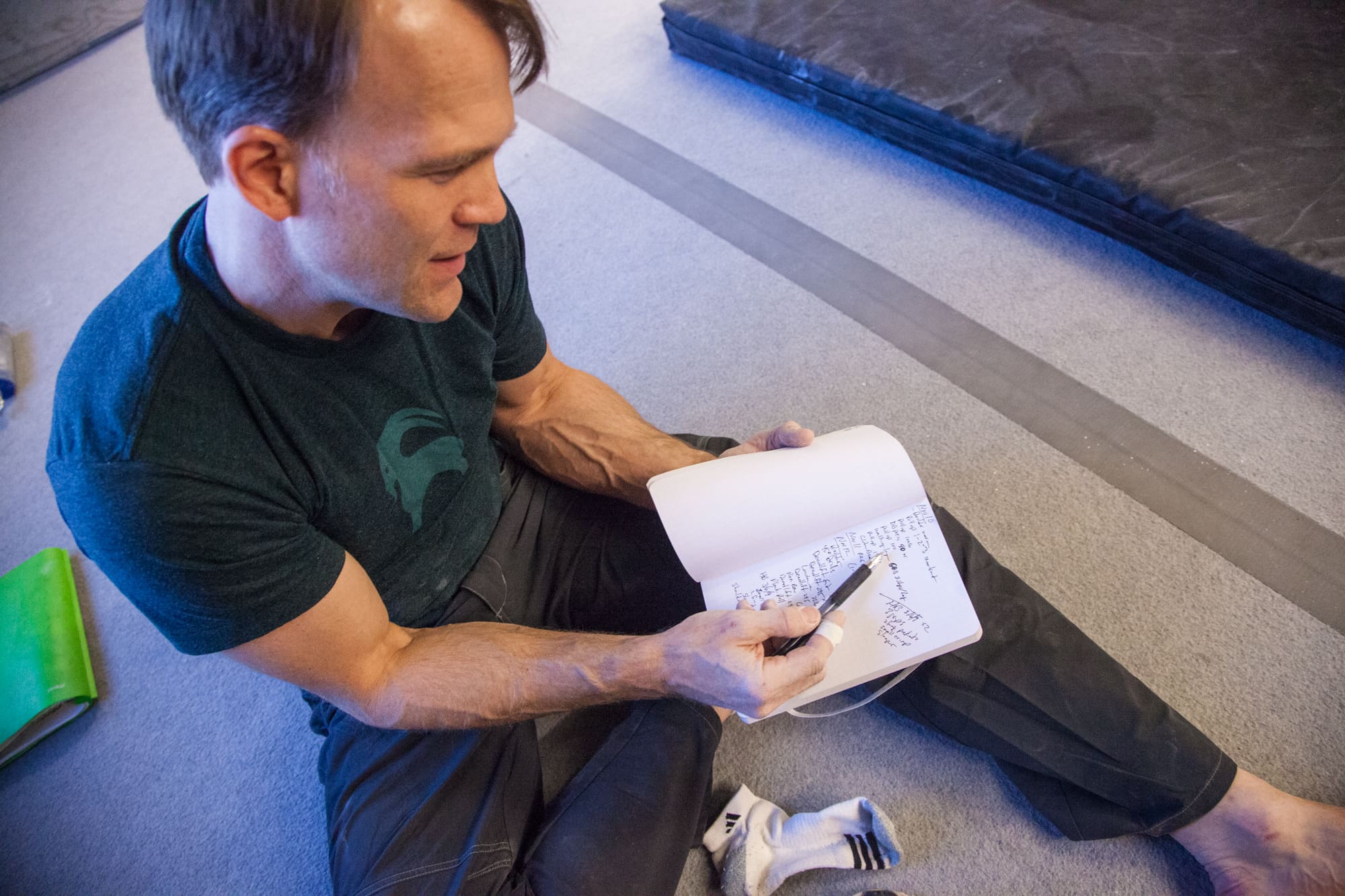by Jon Vickers /
The Dreaded Plateau
Remember when you learned to keep your arms straight or push with your legs? Maybe you learned to control your breathing, loosen your grip or just turn your hips and made a huge jump in climbing ability. You may have even jumped a whole letter grade when you made the smallest technical discovery. These improvements accelerated your progress when you began climbing, but what are your options when your technical skills cease to improve as quickly?
If you climb long enough, the dreaded plateau will happen to you. Whatever you have been doing to make incremental improvements in climbing stops working. You get stuck at a grade that seems impossible to surmount and no matter how much you try, you just can’t seem to make progress.
Despite some of the most talented among us, making continuous gains for most climbers eventually requires a systematic approach to training. For some, this is a very disciplined training routine and for others this is a more flexible strategy that incorporates training theory into their everyday climbing. The stronger you get, the harder it is to make even the smallest of improvements and the smarter you must train to see gains.
Training doesn’t have to be work, it can be fun.
“Oh, you train? I just like to have fun while climbing,” is what some will say. This drives me nuts! It isn’t that it’s wrong to approach climbing casually, but this kind of thinking suggests that having a systematic approach to climbing can’t possibly be fun. On the contrary, I love training, I love trying hard and having the opportunity to plan my climbing with distinct goals in mind and inevitable improvements on the horizon. I would argue that some of those that train must be having the most fun. Otherwise, why would they invest so much time, sweat and hard work to it.
What is training?
Training is what you make it. Some people like to train a lot and crush their project; others just use training concepts to guide their climbing in hopes of some improvement. Either way, knowledge is power and climbing in an informed way is the best way to improve quickly. Elite climbers aside, most climbers will see improvement with any approach that keeps them psyched and allows them to be consistent. Being amped to work hard and being committed to your plan are by far the most important elements to any training protocol.
Some Training Theory
With all the books, blog posts and bros with ideas out there, it is hard to make sense of it all. I wish I could give you a clear answer, but it isn’t straightforward. There are different approaches, cycles and opinions everywhere you look. Just take comfort in the fact that a plan you can commit to and consistently execute is the best one for you. That could be choosing crags that allow you to transition through certain training phases or it could be a well regimented program of hangboarding, lifting and system training. I tend to find myself somewhere in the middle, but know successful climbers at every point along that spectrum.
That being said, let’s talk basics. Training relies on a systematic approach that allows a climber to maximize their time and energy in order to improve their climbing in a variety of categories. These categories can be the technical, mental and physical components that Eric Horst describes in Training For Climbing, but more often refer to the different physical components we need to climb. These components are strength, power, power-endurance and endurance (see figure 1). Many will schedule their training of these components in a particular way. This is known as periodization.
Figure 1.
| Term | Definition | Example Exercise |
| Strength | Strength is in reference to your maximum output for holding a static position. This can be in terms of maximum finger strength, lockoff strength or other categories. | Limit Bouldering, Hangboarding |
| Power | Power is a climber’s ability to apply strength in a given amount of time. This is often related to the ability to make a movement such as a deadpoint. | Limit Bouldering, Campusing |
| Power-endurance | The ability to perform many powerful moves in concession without much rest. Often this is on long problems and shorter routes. | Long Problems, Short Routes |
| Endurance | The ability to climb for extended periods of time. This is generally the type of fitness needed for long routes. | Long Routes |
Periodization as defined by the Rock Climber’s Training Manual is “a strategy for physical training in which different training activities are performed in accordance with a carefully designed schedule to achieve a synergistic effect on the overall performance that results in a performance peak at a predictable time” (Anderson 2014). Many consider this to be a safe approach to making climbing improvements that limits the tendency to overtrain which often leads to injury and a decrease in performance. To learn more about the different types of periondied schedules, check out this article from TrainingBeta.com or this article from SendBotClimbing.com about the pros and cons of each method.
One approach to periodization is to spend a month or more training each of the physical components with its own distinct phase. This type of training schedule is very popular among climbers and other athletes and is known as ‘linear periodization.’ The benefit of this type of schedule is that it creates a predictable performance peak at the end. This is a great way to ensure a peak for a particular season, trip or project.
This series of articles will introduce each of the components important to climbing fitness and will loosely follow a linear periodized schedule. Each phase will have an article describing the basics of the phase and several additional articles describing ways to train at Momentum. This series is by no means an exhaustive look at training, but will provide a foundation for starting your journey of improvement and understanding of training concepts. The series will run into the summer when we encourage you to go outside and enjoy the lessons of the Wasatch and the surrounding areas. Take a look at the schedule of posts below and get psyched for a great summer of sending!
Our Training Series Schedule
Base Fitness: April/May
- Article 1: Intro to Series
- Article 2: Base Fitness and Volume
- Article 3: ARC Training
- Article 4: Continuous Intensity Repetitions (CIRs)
Strength: May/June
- Article 1: What is Strength?
- Article 2: Finger Training Basics
- Article 3: Sport Specific Lifts for Climbing
Power: June/July
- Article 1: What is Power?
- Article 2: Limit Bouldering
- Article 3a: Bouldering Projects (with Kyle O’Meara)
- Article 3b: The Guide to Sending in Boulders in LCC (with Steven Jeffery)
Power Endurance: July/August
- Article 1: What is Power Endurance?
- Article 2: 4x4s, Circuits and Intervals
- Article 3: The Guide to Sending in American Fork (with Jeff Pedersen)
Endurance: August/September
- Article 1: What is Endurance? (Types of Endurance)
- Article 2: Gym workouts for Endurance (cascades etc.)
- Article 3: The Guide to Sending in Maple (with Jeff Pedersen)
Performance/Skill Acquisition: September/October
- Article 1: What is Skill Acquisition? The Gains that Never Leave!
- Article 2: 5 Rock Types and 5 Tips
- Article 3: Vertical Vs. Steep Terrain
Our Next Article >> “Train to Send: Volume Phase”
Works Cited and Further Reading:
The Self Coached Climber by Dan Hague and Douglas Hunter
The Rock Climber’s Training Manual by Michael and Mark Anderson
Training for Climbing by Eric Horst


